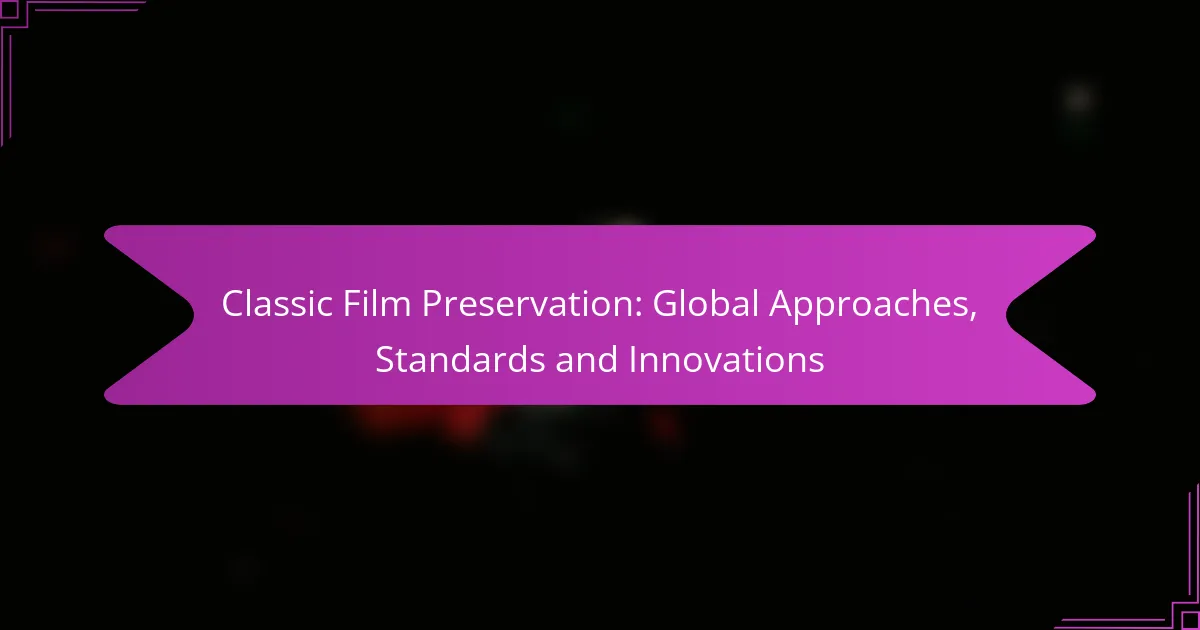The preservation of classic movies is becoming increasingly vital as the film industry embraces digital strategies to safeguard these cultural treasures. Key approaches include cloud storage, digital restoration, and online archiving, which enhance accessibility for future audiences. However, challenges such as limited funding, outdated technology, and legal complexities continue to pose significant hurdles in the preservation efforts.

What are the key digital strategies for classic movie preservation?
Key digital strategies for classic movie preservation include utilizing cloud storage, implementing digital restoration techniques, leveraging online archiving platforms, and adhering to metadata standards. These approaches ensure that classic films are not only preserved but also accessible for future generations.
Cloud storage solutions
Cloud storage solutions provide a scalable and secure way to store classic films digitally. By using services like Amazon S3 or Google Cloud Storage, film archives can protect their collections from physical damage and ensure easy access for restoration and research purposes.
When selecting a cloud provider, consider factors such as data redundancy, security measures, and cost. Many providers offer tiered pricing based on storage needs, making it easier to manage budgets while ensuring the safety of valuable film assets.
Digital restoration techniques
Digital restoration techniques involve using software to repair and enhance classic films. This can include removing scratches, correcting color, and improving audio quality. Tools like Adobe After Effects and DaVinci Resolve are commonly used in the industry for these purposes.
It’s essential to balance restoration with preservation; over-restoring can alter the film’s original aesthetic. Establishing clear guidelines for restoration processes can help maintain the integrity of the original work while making it more enjoyable for modern audiences.
Online archiving platforms
Online archiving platforms, such as the Internet Archive or Archive.org, allow institutions to share classic films with a global audience. These platforms provide a space for films to be stored, accessed, and even streamed, increasing their visibility and engagement.
When choosing an online archiving platform, consider the platform’s user base, ease of use, and the ability to support various file formats. Collaborating with these platforms can enhance outreach efforts and promote awareness of classic cinema.
Metadata standards for film
Metadata standards for film are crucial for organizing and retrieving digital collections effectively. Standards like the Dublin Core or the PBCore framework help catalog films with essential information such as title, director, and production year, making it easier for researchers and audiences to find specific works.
Implementing consistent metadata practices can significantly improve searchability and accessibility. Ensure that all digital files are tagged accurately and updated regularly to reflect any changes in the film’s status or ownership.

What challenges does classic movie preservation face?
Classic movie preservation faces significant challenges, including limited funding, outdated technology, and complex legal issues. These obstacles hinder efforts to restore and maintain films for future generations.
Funding and resource allocation
Securing adequate funding for classic movie preservation is a major challenge. Many preservation projects rely on grants, donations, and public funding, which can be inconsistent and competitive. Organizations must prioritize resource allocation effectively to ensure that critical films receive the attention they need.
To enhance funding opportunities, institutions can collaborate with film festivals, educational programs, and cultural organizations. Establishing partnerships can lead to shared resources and increased visibility, which may attract potential donors.
Technological obsolescence
Technological obsolescence poses a significant risk to classic movie preservation. As film formats evolve, older technologies may become difficult to access or repair, leading to potential loss of films. Institutions must stay updated on current technologies to ensure they can effectively digitize and restore classic films.
Investing in versatile digital formats and maintaining equipment for older technologies is essential. Regularly assessing the preservation methods and adapting to new advancements can help mitigate the risks associated with technological changes.
Legal and copyright issues
Legal and copyright issues complicate classic movie preservation efforts. Many films are still under copyright, which can restrict access to materials needed for restoration. Navigating these legal landscapes requires a solid understanding of copyright laws and potential licensing agreements.
Preservation organizations should seek legal counsel to clarify rights and permissions. Engaging with copyright holders and exploring fair use provisions can also facilitate access to films for preservation purposes, ensuring that classic cinema remains accessible to future audiences.

How is the film industry adapting to digital preservation?
The film industry is increasingly adopting digital preservation techniques to safeguard classic movies for future generations. This shift involves leveraging technology and collaborative efforts to ensure that films are not only preserved but also remain accessible in a rapidly evolving digital landscape.
Collaborations with tech companies
Film studios are forming partnerships with technology companies to enhance digital preservation efforts. These collaborations often focus on developing advanced storage solutions, utilizing cloud technology, and implementing artificial intelligence for better cataloging and restoration processes.
For example, some studios are working with companies that specialize in data archiving to create secure, long-term storage systems that can withstand the test of time. Such partnerships can lead to innovative approaches that improve both the quality and longevity of preserved films.
Investment in preservation initiatives
Investment in preservation initiatives is crucial for maintaining the integrity of classic films. Many film organizations and studios are allocating funds specifically for restoration projects, which can range from digitizing old reels to enhancing audio and visual quality.
In some cases, grants and public funding are also available to support these initiatives, encouraging a broader commitment to preserving cultural heritage. By prioritizing these investments, the industry can ensure that iconic films remain available for audiences today and in the future.

What role do film festivals play in preservation efforts?
Film festivals play a crucial role in preservation efforts by providing a platform to showcase restored films and raise awareness about the importance of preserving cinematic history. They facilitate connections between filmmakers, audiences, and preservation organizations, fostering a community dedicated to maintaining film heritage.
Showcasing restored films
Film festivals often feature screenings of restored classics, allowing audiences to experience these works in their intended quality. This not only highlights the technical achievements of restoration but also emphasizes the cultural significance of these films. For instance, festivals like Cannes and TIFF regularly include restored versions of iconic films, drawing attention to their historical context.
By showcasing restored films, festivals can attract both cinephiles and casual viewers, creating opportunities for discussions about film preservation. Engaging panels and Q&A sessions with restoration experts can further educate audiences on the challenges and techniques involved in preserving these works.
Raising awareness and funds
Film festivals serve as vital platforms for raising awareness about the need for film preservation. They often host fundraising events, auctions, or special screenings where proceeds go directly to preservation initiatives. This financial support is essential for organizations that work to restore and maintain classic films.
Additionally, festivals can partner with non-profits and educational institutions to promote preservation efforts. By leveraging their visibility, festivals can mobilize community support and encourage donations, ensuring that important films are preserved for future generations. Engaging storytelling about the impact of preservation can resonate with audiences, motivating them to contribute to these causes.

How can audiences contribute to classic movie preservation?
Audiences can play a vital role in classic movie preservation by actively engaging in funding initiatives and joining preservation organizations. Their support helps ensure that these films are restored, archived, and made accessible for future generations.
Supporting crowdfunding campaigns
Many classic movie preservation projects rely on crowdfunding to gather the necessary funds for restoration and archiving. Platforms like Kickstarter and Indiegogo allow fans to contribute directly to specific film projects, often in exchange for rewards such as exclusive merchandise or early access to screenings.
When considering participation, look for campaigns that clearly outline their goals, budget, and timeline. Successful campaigns typically raise anywhere from a few thousand to several hundred thousand dollars, depending on the project’s scope and the film’s popularity.
Participating in preservation organizations
Joining preservation organizations is another effective way for audiences to contribute to classic movie preservation. Groups like the National Film Preservation Foundation and the American Film Institute focus on safeguarding cinematic heritage and often welcome new members who can volunteer or donate.
Membership benefits may include access to exclusive screenings, newsletters, and opportunities to participate in preservation events. Engaging with these organizations not only supports their missions but also connects you with like-minded individuals passionate about film history.

What are the future trends in classic movie preservation?
Future trends in classic movie preservation focus on leveraging digital technologies to enhance restoration efforts and accessibility. Innovations such as artificial intelligence, cloud storage, and virtual reality are reshaping how films are preserved, making them more accessible to audiences worldwide.
Digital Restoration Techniques
Digital restoration techniques are becoming increasingly sophisticated, utilizing AI to enhance image quality and repair damaged footage. These methods can significantly reduce the time and cost associated with traditional restoration processes, allowing for more films to be preserved. For instance, AI algorithms can analyze frames to identify and correct imperfections, often achieving results that were previously unattainable.
Cloud Storage Solutions
Cloud storage solutions are transforming how classic films are archived and accessed. By storing films in the cloud, preservationists can ensure that they are protected against physical degradation and loss. Additionally, cloud-based systems facilitate collaboration among institutions, allowing for shared access to rare films and resources across different regions.
Virtual Reality Experiences
Virtual reality (VR) is emerging as a novel way to engage audiences with classic films. By creating immersive experiences, VR can transport viewers into the film’s world, enhancing their appreciation and understanding of the work. This trend not only preserves the films but also revitalizes interest among younger generations who may be less familiar with classic cinema.
Challenges in Preservation
Despite advancements, challenges in classic movie preservation remain significant. Funding is often limited, and many institutions struggle to secure the resources needed for comprehensive restoration projects. Additionally, the rapid pace of technological change can make it difficult to choose the right tools and methods for preservation, leading to potential obsolescence of techniques.
Collaboration Among Institutions
Collaboration among film archives, museums, and educational institutions is crucial for successful preservation efforts. By pooling resources and expertise, these organizations can tackle larger projects and share best practices. Initiatives like joint restoration projects and shared databases can enhance the preservation landscape and ensure that classic films remain accessible for future generations.



